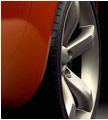For Release: April 17, 2001
Contact:
Charles Licari, GM
810-986-0077
charles.licari@gm.com
Rolf Olsen, The University of Tulsa
918-631-2653
rolf-olsen@utulsa.edu
Tulsa, Okla. -- General Motors is turning to The University of Tulsa to help keep lean burn engines in the portfolio of technology for future U.S. emission standards.
Richard Blint, a senior research scientist with the Chemical and Environmental Sciences Lab at GM's Research & Development Center in Warren, Mich. and a member of the research team,. says lean burn engines are more fuel efficient than the standard gasoline engine because they burn higher ratios of oxygen to fuel, but they can't meet pollution standards that will be in effect in three years. The excess oxygen tends to produce oxides of nitrogen that current catalytic converters are unable to remove in a lean-burn system.
The team is researching catalytic materials that will be both durable and efficient for "lean burn" engines, including diesels. Very few catalysts operate lean, and those that do either are not efficient enough to meet government standards, or do not last long enough to be economically feasible, according to Blint.
"Lean burn engines provide high efficiencies," Blint says. "However, the emissions standards that will be phased in between 2003-2007 are very stringent. We need a new catalyst technology to be able to use lean burn engines in a broad spectrum of vehicles."
The research is centered on copper zeolites, says Geoffrey Price, chairman of TU's chemical engineering department and research partner. These zeolites are made with aluminum, silicon and copper, which is the active ingredient that promotes the chemical reaction in a catalyst to clean up a vehicle's exhaust fumes. The zeolite, a porous structure, supports the copper and contributes to desired catalytic properties of copper. The catalyst is designed to convert nitrogen oxides -- components that can lead to the creation of ozone -- into nitrogen and water.
"Copper zeolites as emission control catalysts have generated tremendous interest in the last decade because they are so much cheaper than the platinum- or palladium-based materials currently used," says Price. "However, even though the copper zeolites have shown some very positive properties, stability has been a deal breaker up to now," he says. Zeolites so far have tended to break down under the high temperatures of the exhaust gas and their ability to promote the catalytic reaction declines. The copper zeolite catalysts developed up to now lose most of their activity well before a vehicle has reached 100,000 miles of usage. Under federal mandates, emission systems should operate correctly for 120,000 miles.
GM has made some important discoveries in the area of stability, and TU will help evaluate and improve the zeolites for possible applications.
Price is preparing zeolites and investigating various methods for loading the zeolites with copper. GM's R & D Center is testing the materials for catalytic activity and for structural integrity.
Funding for the project is being provided by both GM and the National Science Foundation.
A private institution with approximately 4,200 students, The University of Tulsa, located in Tulsa, Okla., is nationally recognized for its humanities-based undergraduate curriculum, engineering and natural sciences programs, and global initiatives.




